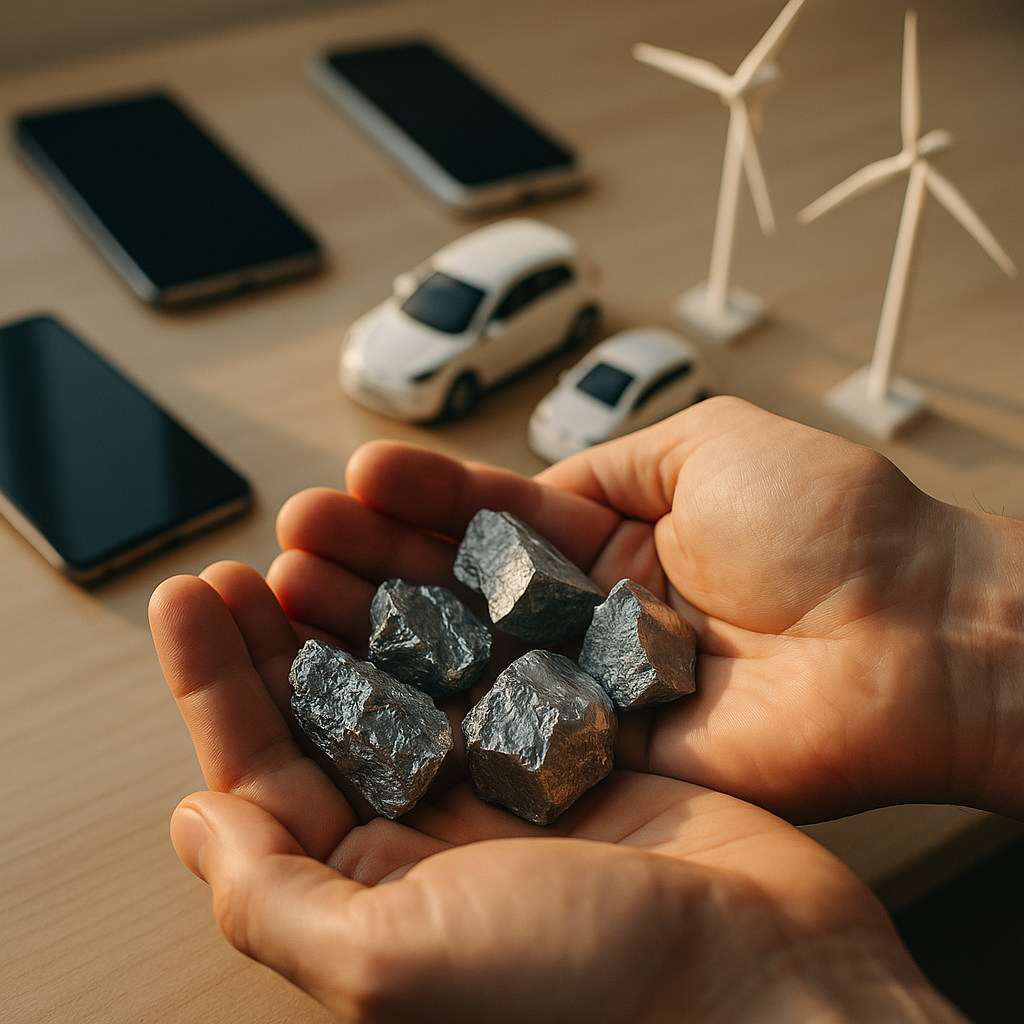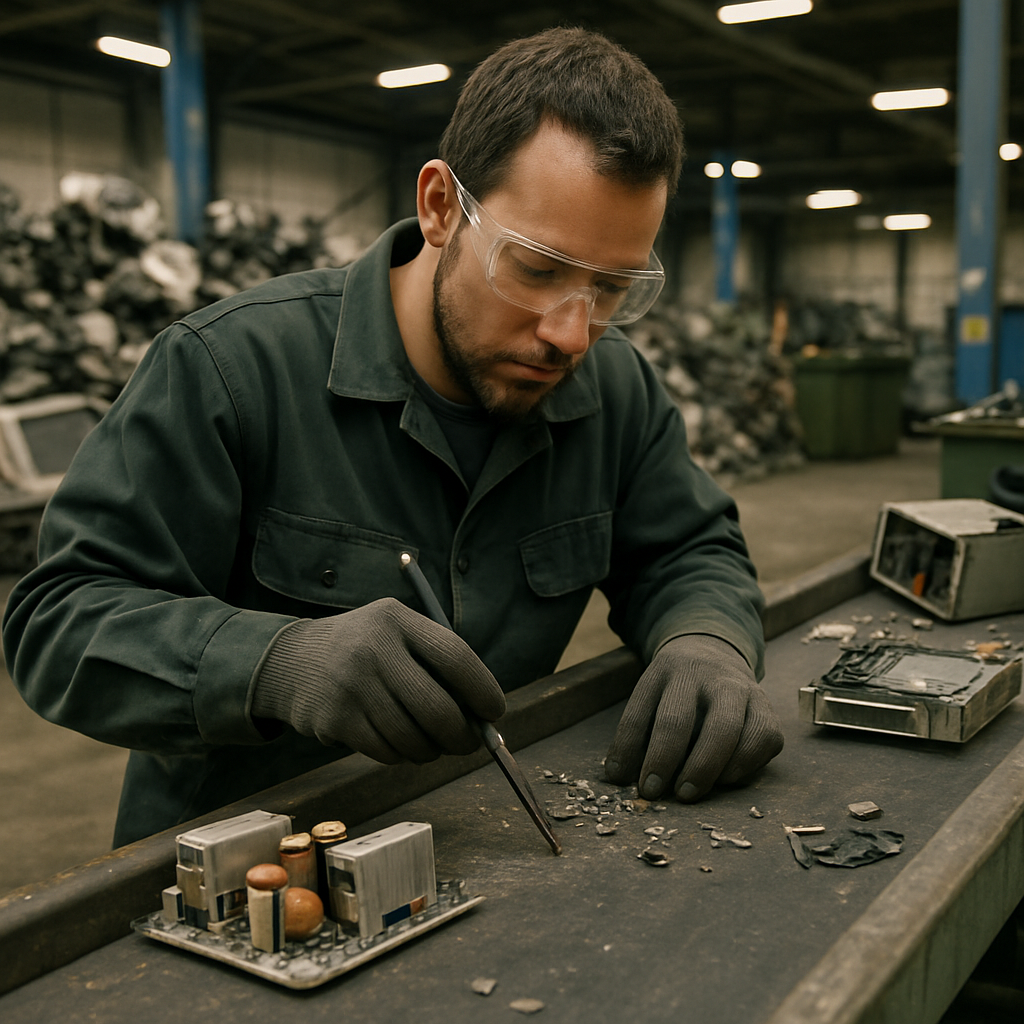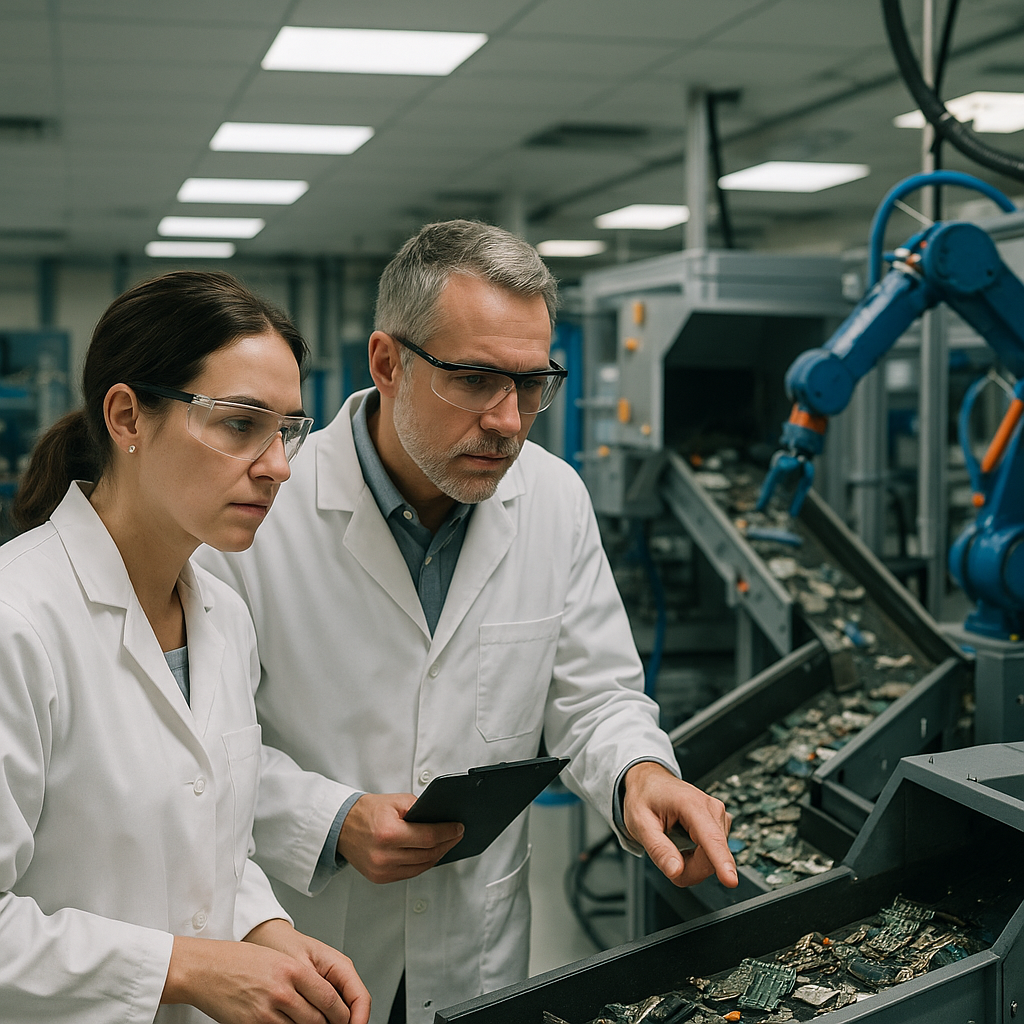5901 Botham Jean Blvd, Dallas, TX 75215
Why Rare Earth Metals Recycling Matters: From E-Waste to Sustainable Supply Chains
August 19, 2025Extracting just one ton of rare earth elements can produce up to 2,000 tons of toxic waste. This staggering statistic highlights the urgent need for sustainable alternatives in our increasingly technology-dependent world. As global demand for these critical materials surges, natural reserves face unprecedented pressure.
Rare earth metals—a group of 17 elements with unique magnetic, luminescent, and electrochemical properties—are indispensable components in modern technologies. From smartphones and electric vehicles to wind turbines and defense systems, these elements enable the devices that power our daily lives. Yet, their extraction comes at a tremendous cost. Mining operations cause habitat destruction, water contamination, and release radioactive byproducts into the environment.
The economic implications are equally concerning. With China controlling approximately 85% of global production, supply chain vulnerabilities create price volatility and resource insecurity for many nations. Recycling rare earth metals offers a promising solution. By recovering these valuable materials from discarded electronics and industrial waste, we can reduce reliance on destructive mining practices while securing a more sustainable supply chain. This circular approach not only conserves finite resources but also minimizes the environmental damage associated with traditional extraction methods.
What Are Rare Earth Metals and Where Are They Used?

Despite their name, rare earth metals are not actually scarce in the Earth’s crust. This group of 17 chemical elements includes the 15 lanthanides plus scandium and yttrium. They are considered “rare” because it is challenging to find these in concentrations suitable for economical extraction. These elements possess unique magnetic, luminescent, and catalytic properties that are essential for modern technology.
Key Components in Everyday Technology
Rare earth elements are vital in many everyday devices. Neodymium, one of the most in-demand rare earth elements, is used to create powerful magnets found in smartphones, headphones, and computer hard drives. These magnets are highly efficient, supporting the miniaturization of electronic components without compromising performance.
In consumer electronics, rare earths have multiple roles. Europium and terbium contribute the red and green colors in smartphone and television screens. Yttrium is used in LED lights and camera lenses, while lanthanum is found in high-end camera lenses and telescope optics due to its light-refractive properties.
Crucial for Clean Energy Technologies
The shift to renewable energy heavily depends on rare earth metals. In wind turbines, particularly offshore models, neodymium-iron-boron magnets are critical components. A single large wind turbine can contain up to 200 kilograms of rare earth materials. Similarly, electric vehicles rely on these elements for their motors and batteries.
Key applications in renewable energy and transportation include:
- Wind turbines: Neodymium, dysprosium, and praseodymium for permanent magnets
- Electric vehicles: Up to 4 kg of rare earths in motors and power systems
- Hybrid vehicles: Battery systems and electrical components
- Catalytic converters: Cerium and lanthanum for emissions reduction
Defense and Advanced Applications
Rare earth elements are crucial in defense technologies. They are used in guidance systems, radar, sonar equipment, and laser targeting. For instance, an F-35 fighter jet contains approximately 400 kg of rare earth materials across various systems.
Other advanced applications include:
- Medical devices: MRI machines and medical imaging equipment
- Telecommunications: Fiber optic cables and network infrastructure
- Scientific research: Superconductors and nuclear reactors
- Space exploration: Specialized components for satellites and spacecraft
China’s Dominance in the Global Supply Chain
China currently controls over 69% of global rare earth production and about 90% of processing capacity. This dominance spans the entire value chain, from mining to refining to manufacturing finished products. The country’s lead is due to factors like vast natural reserves, especially in Inner Mongolia, and decades of investment in processing technology.
While other countries have rare earth deposits, China’s strategic advantage lies in its integrated supply chain and advanced refining capabilities. The Chinese government has recognized the strategic significance of these resources since the 1980s, when Deng Xiaoping famously noted, “The Middle East has oil, China has rare earths.”
This market concentration creates supply vulnerabilities for industries reliant on rare earth elements. Nations like the United States, Australia, and Canada are now working to establish alternative sources and processing facilities, though developing a competitive supply chain outside China remains challenging due to economic and technological hurdles.
Challenges in Recycling Rare Earth Metals

Recycling rare earth metals involves addressing a complex landscape of technical hurdles and economic constraints. These critical materials are essential for modern technologies, but recovering them from end-of-life products requires overcoming significant obstacles at every stage of the process.
Technical Extraction Challenges
One of the primary difficulties in recycling rare earth metals is their dispersion within products. Unlike common metals such as steel or aluminum, rare earths are used in small quantities and are tightly integrated into complex components, similar to trying to recover a few drops of food coloring mixed throughout a cake once it’s baked.
The physical extraction process also presents challenges. Many rare earth-containing components are embedded in devices using strong adhesives or complex assemblies. For instance, extracting magnets from electric vehicle motors often requires manual disassembly because the magnets are glued into rotors, making the process labor-intensive and increasing recycling costs.
The absence of standardized labeling compounds these difficulties. Recyclers often can’t identify which products contain rare earth metals or where they’re located within a device. This forces them to use time-consuming identification methods or process everything through less efficient bulk recycling systems.
Process Limitations
Current recycling technologies for rare earth metals face significant limitations. The two main approaches each have their own challenges:
Hydrometallurgical processes use chemical solutions to dissolve and separate rare earth elements. While effective, these methods consume large quantities of water and chemicals, which can be environmentally harmful if not managed properly. The process also involves multiple steps, increasing cost and complexity.
Pyrometallurgical approaches, which use high temperatures to separate materials, are energy-intensive and can generate significant carbon emissions and solid waste. The high energy requirements make these processes particularly vulnerable to fluctuating energy prices.
The hydrogen-based recycling method (known as HPMS – Hydrogen Processing of Magnetic Scrap) offers a promising alternative but requires high-purity feedstock to be effective. Contaminants like coatings and oxidation can significantly reduce output quality, limiting its application to well-preserved waste streams.
| Recycling Technology | Recovery Rate | Notes |
| Mechanical Recycling | 9% – 73% | Best economic and environmental performance |
| PET Glycolysis | 9% – 73% | Best economic and environmental performance |
| Lithium-ion Battery Recycling | 40% – 60% | Limited recovery of lithium and graphite |
Economic Viability Challenges
The economics of rare earth recycling create substantial barriers to widespread adoption. The high costs of collection, processing, and refining mean recycled rare earths often struggle to compete with newly mined materials, especially when global prices are low.
Price volatility in rare earth markets creates significant uncertainty for recycling investments. When prices drop, recycling operations can quickly become unprofitable, making it difficult to secure long-term financing for recycling facilities.
Competition from non-EU suppliers, particularly China, which dominates global rare earth production, creates additional economic pressure. Primary production in regions with lower environmental standards and labor costs can undercut the price of recycled materials from regions with stricter regulations.
Infrastructure and Supply Chain Gaps
Building a functional rare earth recycling industry requires specialized infrastructure at every stage of the process. Many regions lack collection systems specifically designed for rare earth-containing products. For example, small electronic devices containing valuable rare earth magnets often end up in general waste streams rather than dedicated recycling channels.
The recycling landscape remains fragmented with incomplete recycling loops. Effective recycling requires coordination between original equipment manufacturers, dismantlers, recyclers, refiners, and end-users of recycled materials, yet these networks remain underdeveloped in many regions.
Another significant challenge is the current shortage of end-of-life products with high rare earth content. While millions of electric vehicles and wind turbines containing substantial amounts of rare earth metals will eventually require recycling, most are still in use. This creates a chicken-and-egg problem where recycling facilities need volume to be economical, but insufficient volume exists to justify building facilities.
Innovation Addressing Challenges
Despite these substantial obstacles, innovative approaches are emerging to address rare earth recycling challenges. Advances in automated dismantling technologies aim to reduce the labor costs associated with extracting rare earth components from complex products. Meanwhile, more efficient chemical processes are being developed to reduce environmental impacts and processing costs.
Policy innovations are also helping overcome economic barriers. Extended producer responsibility requirements, recycled content mandates, and financial incentives for recycling can help create more favorable economics for rare earth recycling. Digital product passports that provide information about material content could significantly improve identification and sorting efficiency.
As volumes of end-of-life products containing rare earths increase and technologies mature, recycling is expected to play an increasingly important role in rare earth supply chains. While challenges remain substantial, the strategic importance of these materials continues to drive investment in solutions that can overcome current technical and economic barriers.
Innovations and Future Outlook for Rare Metal Recycling

The rare earth metals recycling industry is undergoing significant technological change. Breakthrough innovations are turning what was once a costly, inefficient process into an economically viable and environmentally friendly practice. These advancements are timely, as global demand for rare earth elements is projected to triple by 2035, driven by clean energy technologies and electric vehicles.
Cutting-Edge Recycling Technologies
Bioleaching is one of the most promising innovations in rare earth recycling. This technique uses specialized bacteria to extract rare metals from waste materials. Scientists at universities worldwide have refined bioleaching processes capable of recovering up to 90% of rare earth elements, using significantly less energy and producing fewer toxic byproducts than conventional methods.
Advanced sorting systems powered by artificial intelligence are improving how we identify and separate rare earth-containing components. These systems can efficiently process large volumes of electronic waste, accurately identifying components with valuable elements. This addresses a key bottleneck in the recycling chain — the labor-intensive task of identifying and sorting recyclable materials.
Direct recycling methods are also gaining traction. Noveon Magnetics has developed a technique for recycling rare earth magnets without breaking them down into elemental components. This approach reduces energy consumption by about 90% compared to traditional magnet manufacturing while maintaining high-performance standards.
Environmental and Economic Benefits
The environmental benefits of these new recycling technologies are substantial. Traditional rare earth mining generates approximately 2,000 tons of toxic waste per ton of rare earth elements extracted. Modern recycling methods can eliminate this waste stream entirely. Companies like Iowa State University are developing protein-based extraction methods that selectively bind rare earth metals without using harsh chemicals.
From an economic perspective, recycling is becoming increasingly competitive with primary mining. The SEEE process (Selective Extraction-Evaporation-Electrolysis) developed by Kyoto University has achieved recovery rates of 96% for neodymium and 91% for dysprosium, with purities exceeding 90%. These high recovery rates enhance the financial viability of recycling operations.
Industry Growth Projections
Market forecasts are optimistic for the rare earth recycling sector. According to Lucintel, the global rare earth recycling market is expected to reach $1.0 billion by 2030, growing at a compound annual growth rate of 5.3% from 2024 to 2030. This growth is driven by increasing demand from electric vehicles, wind turbines, and consumer electronics.
Recycling capacity is projected to expand significantly over the next decade. Industry experts estimate that recycling could potentially meet up to 25% of global rare earth demand by 2035. This would represent a crucial step toward supply chain security, especially for nations aiming to reduce dependency on dominant producing countries.
Investment in recycling infrastructure is accelerating worldwide. Since 2020, the United States Department of Defense has committed more than $439 million to strengthen domestic rare earth supply chains, with recycling being a key component. Companies like MP Materials and Cyclic Materials are attracting significant capital, including from major tech firms looking to secure sustainable material sources.
Challenges and Future Directions
Despite promising advances, challenges remain. The complexity of rare earth separation continues to be a technical hurdle, though innovations like flash joule heating developed by Rice University researchers show potential for improving efficiency. Market price volatility also affects the economic feasibility of recycling operations, underscoring the need for policy support and long-term offtake agreements.
The industry is moving towards integrated recycling systems that combine multiple innovative approaches. Research institutions and private companies are increasingly collaborating to develop technologies that address different aspects of the recycling process. These partnerships are essential for creating comprehensive, efficient recycling pathways.
Another emerging trend is the development of circular economy business models specifically for rare earth elements. These models design products for easier disassembly and recycling, creating closed-loop systems that maximize resource recovery and minimize waste.
As global demand for clean energy technologies continues to rise, rare earth metal recycling is set to become a cornerstone of sustainable resource management. The innovations emerging today will shape the industry for decades, potentially transforming waste into a valuable, reliable source of critical materials.
Conclusion: The Path Forward for Sustainable Rare Metal Use

The recycling of rare earth metals is crucial for building a sustainable technological future. These critical materials power everything from smartphones to wind turbines, but their extraction has significant environmental costs. Mining just one ton of rare earth elements can generate up to 2,000 tons of toxic waste. This highlights why recycling initiatives are not merely beneficial but essential for our planet’s health.
While challenges persist in the rare metal recycling sector, innovative technologies are rapidly changing the field. Advanced AI-driven sorting systems, flash joule heating, and biohydrometallurgy techniques are improving recovery rates and making the recycling process more economically viable. These technological breakthroughs, along with growing awareness and supportive global policies, offer promising ways to overcome current obstacles. By embracing these solutions, we can reduce our reliance on environmentally harmful mining practices and create more resilient supply chains for these vital resources.
For businesses and individuals looking to contribute to this important environmental effort, contact Okon Recycling at 214-717-4083. Their expertise in sustainable rare metal recycling can help transform your waste into valuable resources while supporting a more circular economy for future generations.
